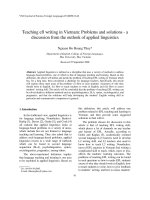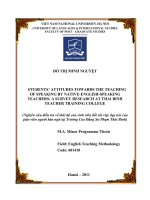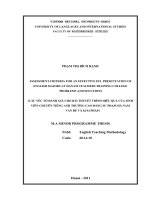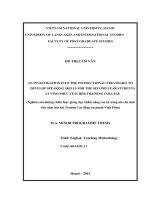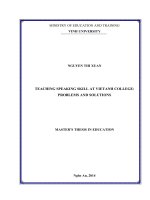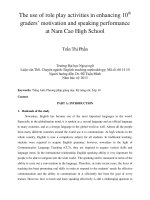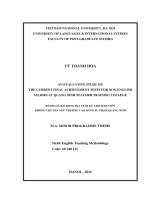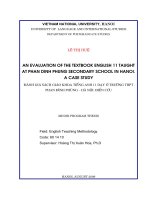Appying testing of speaking tetst at Nam Dinh teacher traning college: Problems and solutions
Bạn đang xem bản rút gọn của tài liệu. Xem và tải ngay bản đầy đủ của tài liệu tại đây (430.96 KB, 8 trang )
100
TRƯỜNG ĐẠI HỌC THỦ ĐÔ HÀ NỘI
APPYING TESTING OF SPEAKING TETST AT NAM DINH
TEACHER TRANING COLLEGE: PROBLEMS AND SOLUTIONS
Tran Quoc Viet(*)
Hanoi Metropolitan University
Abstract: This study investigates the application of testing assessment methods on speaking
test skills through the participation of 30 second-year students of Nam Dinh teacher training
college. Based on the analysis of the results, it was shown that the lecturers used different
assessment types and steps to evaluate the students’ speaking skills. However, they still faced
up with some problems such as not having enough time to evaluate all student activities and
meeting difficulties in classifying oral tests. In addition, the article also gives some suggestions
to overcome the obstacles with the hope of contributing to improving the qualities of testing
and evaluation in the near future.
Keywords: Assessment, speaking test, assessment test.
Received 16 July 2022
Revised and accepted for publication 23 August 2022
(*) Email:
1. INTRODUCTION
Assessment – both thinking about it and actively planning for it- gets put on the back burner
because we get caught up in the “now” of teaching. “What will I do in class next week?” is a
far more consuming question for new teachers than” How do I know if my students are
learning?”, but Teoh, Coggins, Guan, & Hiler (2014) found that “many teachers feel that test
preparation takes up instructional time as well” and “the prepping for the test takes a lot of time.
Instead of possibly doing projects or more hands-on learning, we really focused on the testing
format and preparing our students to be comfortable taking the test. The prepping starts at the
beginning of the year and ends in April”. This is a considerable portion of time and it behooves
us to take time to think about it. I believe that assessment can be a process in which both students
and teachers can find out how they are doing. Upon this base, I have three branches: that
teachers need to function within the reality of their situation that final grades reflect a variety
of assessment techniques, and that students are aware of the techniques used. Who can give a
TẠP CHÍ KHOA HỌC − SỐ 63/2022
101
reliable assessment? Some researchers believed that the teacher is an excellent teacher if they
have the trusts assessment.
Testing is an important part of every teaching and learning experience, because the effect
of testing on teaching and learning can be harmful or beneficial. It can be beneficial when a test
is regarded as important and preparation for it comes to dominate all teaching and learning
activities. In contrast, it can be harmful when the test contents and testing techniques are at
variance with the objectives of the course. Good English tests can help create positive attitudes
towards instruction by giving students a sense of accomplishment and a feeling that teachers’
evaluation of the test matches what he has taught them. They also help students learn the
language by requiring them to study hard, emphasizing course objectives, and by showing them
what they need to improve. In addition, teachers can use tests to diagnose their own efforts as
well as those of their students.
As a teacher of English, I am fully aware of the importance of testing “is to help language
teacher write better tests” (Hughes, 2003: XI) and “both teaching and testing are so closely
inter-related that it is virtually impossible to work in either field without being constantly
concerned with the other” (Heaton, 1988: 5). It is obvious that the relationship between teaching
and testing is that of partnership. However, there are sometimes some problems with test and
test administration at my institution and elsewhere. This is because some teachers are not sure
how to design a good test “it takes the view that test construction is essentially a matter of
problem solving, with every teaching situation setting a different testing problem. In order to
arrive at the best solution for any particular problem - the most appropriate test or testing
system. It is not enough to have at one’s disposal a collection of test techniques form which to
choose. It is also necessary to understand the principle of texts and how they can be applied in
practice” (Hughes, 2003: XI). In this article, I go through a test specification and a sample speaking test for the English majors in their 4th term at Nam Dinh Teacher Training College. I
also provide and article on testing at my institution in which I focus on testing situation,
problems and suggested solutions.
2. CONTENT
2.1. Test specifications for a progress test of speaking
2.1.1. The test’s purpose
In developing language test, numerous researchers concluded that a test for an oral class
must measure student’s oral ability. In order to get a truly valid assessment of our students only,
we need to give oral exams. The speaking test for the second year students of English is
designed to assess the student’ progress in the application of language and language functions
in their communication. The focus of the test is on fluency and accuracy of the English
language.
2.1.2. Brief description of the test takers
To make this speaking test, the test takers are 30 second year students majoring in English
(24 female students and 6 male students). These include students coming from different areas
102
TRƯỜNG ĐẠI HỌC THỦ ĐÔ HÀ NỘI
in Nam Dinh province. They are doing their three-year study course to become teachers of
English at lower secondary schools. All of them are Vietnamese by origin and their ages vary
from 19 to 21 “for adults, learning to speak a new language is in many case far from satisfactory
simply because they feel they need to cope with many different aspects at one time and that
seems to be impossible in real conversation” (Betsabe’, 2007: 18). All of them are still single.
Because our college is a Teacher Training College, the students do not have to pay tuition fee.
Those who have good result in their study can get scholarship ranging from VND 180,000 to
260,000. This to some extent is encouraging and a positive motivation for students to make
further progress in their studies. The students are in their 4th – semester, which means that their
English proficiency is at a pre-mediate level or higher. The level of these students’ English
proficiency is different. They hold speaking lessons regularly either 2 periods per week and are
expected to take their speaking exam at the end of the semester. They also have chance to
practice speaking during the lesson in other subjects such as integrated English, reading,
listening, country study, and so on.
2.1.3. Test level
This speaking test was made basing on appropriate materials, which students are using at
our institution. The level of the test is equivalent to that of the materials which is PreIntermediate or so.
2.1.4. Description of suitable textbook or language course
One of the course books we use to develop our students’ general English ability is Headway
series, of which Headway Pre-Intermediate (Liz & John Soars, 2000) is used as intergraded
English course book for the 3rd and the 4th terms. The book is very well organized and has highly
systematic skills development work and has also authentic material and tasks to boost student’s
confidence in dealing with real English.
Alongside, Headway Pre-Intermediate is also accompanied by a work book, two cassettes,
a pronunciation book, which provides a range of supplementary activities to practice
pronunciation and intonation. We also use a collage-made speaking material, which is for
internal use only. The book was made by the staff of the Faculty of Foreign Languages to suit
the student’s level and interests and lessons of various topics. Students have good chance to
practice their speaking with a wide range of activities to develop their language functions in
different situations of communication.
2.1.5. Number of sections of the test
For each test, students are requested to ask and answer three or four questions from which
they can expand their answer to prolong the dialogue. These questions are related to the topic
provided in the instructions.
2.1.6. Language skills and language elements to be tested
The test is designed to test students’ speaking skills. That is will assess skills and structures
students have actually learned during the term, such as proper usage of the vocabulary and
grammar items. The test should cover the language input that students have encountered while
TẠP CHÍ KHOA HỌC − SỐ 63/2022
103
learning. Through the fluency and accuracy (pronunciation grammar and vocabulary, and so
on), they are also tested how good their knowledge of functional language is. That is how well
they can apply their English in daily communication.
2.1.7. Test tasks
Students do the test in pairs to ask and answer questions based on the guides in the rubrics.
They have to take turn to ask and answer questions to make a dialogue. Sometimes, they have
to answer the examiner’s questions.
2.1.8. Time allocation
Students are given a certain amount of time to prepare their dialogue then they are called
to sit in front of the examiners (two examiners) to act out their dialogues within the time slot of
about ten minutes.
2.1.9. Test methods
The speaking test is held in a separated classroom building which is convenient for the test.
The exam rooms are clean, quiet, light enough, and on the enter the room for their preparation.
There are about twenty questions in each set and students choose randomly one to prepare for
their dialogue. After 10 minutes, the 1st pair is called to act out their dialogues. They are to
perform their dialogue during their time slot. They are told that they could not read the dialogues
to the examiners, but must speak it as naturally as possible with their partner.
The two examiners sit in front of the students facing to the back of the room. I personally
think this is good because they can prevent the other pairs from cheating (some students may
bring materials into the exam room and copy some ideas from that, or they may ask questions
from other pairs or make noise in general).
During the test time, we always try to put the students at ease and help them warm up by
spending the first few moments just chatting. Sometimes, the examiner (s) can ask them some
questions in order to have a short conversation with them. The questions are related to their
dialogues. For instance, if their dialogues contained references to a birthday party, I would ask
them questions about how Vietnamese/ Chinese people celebrate birthdays. I might also include
a few questions about their preparations for their other exams or their plans for the upcoming
days. This would conclude their oral exam. Two examiners work independently, taking notes
from the students’ performance on the marking sheet and decide what mark they give to the
students. When the first pair of students completes their task in their time slot, they are asked
to sign their names in the list as evidence that they have taken the test.
The first pair is free now, and then the second pair is called to act out their dialogue. The
next pair waiting outside is allowed to enter the exam room for their preparation. The rest do in
turn in the same way. When the exam session is finished, the two examiners come to the
conclusion and decide what mark they give to the students. Students are called to enter the room
to hear some feedbacks and marks from the examiners. This is always done at my college so
that students may avoid the bad things and bring into full play the good things in later times.
104
TRƯỜNG ĐẠI HỌC THỦ ĐÔ HÀ NỘI
2.1.10. Criteria for marking
As it is the end –of term exam, students are expected to do well to pass the exam with good
results. As the criteria for marking designed in the marking sheet, we grade them on
pronunciation, vocabulary, grammar, fluency and listening comprehension. We usually use the
marking sheet for oral test as introduced.
* Criteria for assessing accuracy:
- Grammar: Students use correct word order tenses, agreement….
- Vocabulary: Students have a range of vocabulary that corresponds to the syllabus year
list and use words that have been taught.
- Pronunciation: When students speak, most people will understand, that is their message
they get across is clear.
* Criteria for assessing fluency:
- Lack of hesitation: Students speak smoothly, at a natural speed.
- Length: Students make full sentences and can speak for more than one sentence at a time.
Students can put ideas together to form a message or an argument.
- Independence: When the student is lost for a word or can not express an idea in English,
he finds a way around the problem, re-expressing what he wants to say in a different/simpler
way “negotiation or meaning”. The students can keep talking and asking questions, and so on.
To keep their conversation going. He is independent of the teacher/examiner.
2.2. Testing situation - problems and solutions at Nam Dinh Teacher Training College
I have been working as teacher at Nam Dinh Teacher Training College for three years. I
have had an opportunity to witness its changes and growth over the past years. In the article, I
have an intention of taking about the college’s testing situation. I also analyze some of its
problems and suggest several solutions, and hope that the college will make more outstanding
achievements in the imminent future.
We all know that “the best test, may give unreliable and invalid results if it is not well
administered” (Hughes, 2003: 215). In order to have a good test administration, a list of points
should be done properly. I am very proud of telling about the test preparation and administration
at our college as it has continuously changed in an active way and gained a lot of positive
achievements.
To begin with, our preparation for the exam questions is very careful and thorough. As
Hughes (2003: 215) indicated that “the key to successful test administration is careful advance
preparation”. Based on the written announcement from the director broad, selected teachers the
departments are to design tests for the subjects they are teaching. This is done 3 weeks prior to
the exam with full responsibility. Teachers who teach the same subject for different classes are
to discuss together to make tests. After writing tests, they have to submit the handwriting
versions to the head of divisions for confirmation and verification. Next, the tests are typed,
printed and administered by the Training Department. Tests are carefully checked and well
TẠP CHÍ KHOA HỌC − SỐ 63/2022
105
protected before the exam and verified by the vice-director and then randomly chosen for the
first round of the exam. The level of difficulty of the tests is equivalent in the first round and
the retaking exams.
It is now time for me to talk about test administration. Before each testing session, detailed
instructions are prepared for all examiners. In these, an attempt is made to cover all
eventualities, through the unexpected will always occur; particularly oral examiners must be
thoroughly familiar with the test procedures and rating system to be used. For the Faculty of
Foreign Languages, only teachers who are well trained and experienced are involved, because
we don’t usually have many oral exam rooms so a certain number of oral examiners are
required.
For students or candidates, they are also given full instructions such as where to go, at what
time, what subject to take, what to bring, what they should do if they arrive late, what will they
result from cheating. The name lists of candidates are well prepared and organized with much
information about them such as examination number, date of birth, class, full name, gender,...
and so on.
Rooms for examination at our college are large enough to accommodate comfortably the
planned number of candidates (usually 22-24 candidates). There is sufficient space between
candidates to prevent them from copying from each other “rooms should be quiet and large
enough to accommodate comfortably the intended numbers of candidates. There should be
sufficient space between candidates to prevent copying” (Hughes, 2003: 216). The desks are
well arranged in advance. Ideally, there is a big clock in each room which is visible to all
candidates.
To discuss the test administration at our college, I must say that it is quite good since all
teachers are aware of the importance of a good assessment.
Secondly, the identity of candidates is carefully checked by the examiners. Students must
bring their student card into the exam room for identification. The candidates are always seated
in such a way to prevent friends being in a position to pass information to each other. The
examiners always give clear instructions to candidates about what they are required to do in the
exam room and when they finish the test. Candidates are also warned of the consequences of
any irregular behavior, including cheating. The necessity of maintaining silence throughout the
duration of the test is also emphasized.
Thirdly, when materials are distributed to candidates individually, the examiners usually
instruct them to provide the required details, (such as examination number, name, date…and so
on.) on the answer sheet or test booklet.
Another point is that the examiners time the test precisely; making sure that everyone starts
on time and does not continue after time. When the test is in progress, the examiners (one sitting
in front, at board, the other at the back of the room) carefully monitor the behavior of the
candidates. When there is ten minutes left, the candidates are informed and they have to stop
work immediately when the time is over. Candidates are required to remain in their places until
106
TRƯỜNG ĐẠI HỌC THỦ ĐÔ HÀ NỘI
ail materials have been collected and their numbers checked as well as they have to sign their
names in the name list for verification as evidence.
Since our institution is a provincial college located for from developed centers, it is
inevitable to have some problems here and there. First of all, there is still a shortage of
classroom building used for exam rooms at out college, the college is small, and we have to
work in two shifts (both in the morning and afternoon). In addition, there are different curricula
of study for different learners (regular, irregular, in-service training, correspondence courses
…., and so on.) To gradually improve this, more rooms should be built and as an advantage the
college is preparing for a status of university in the coming years.
Another problem is that acquaintances among the staff and students as I have already
mentioned. Students at our college come from only within the province. Some teachers are their
relatives. It is unavoidable to have some negative effects on exam administration in these cases.
It may happen elsewhere but not only at our institution. A stricter measure should be applied to
raise the awareness in both teachers and students of importance of evaluation. It is the whole
process but not should be frankly criticized and students must be given appropriate punishment
if they violate the exam rules.
Last but not least, students do not try their best to do in exams. As it has been mentioned,
students at our college do not have to pay their tuition fee, they do not seem to show many
efforts, they are quite passive and do not show full responsibility for their studies as well. It is
really not the way if they want to become good teachers at schools. For the better improvement,
I personally think that students at all educational institutions including teacher training colleges
have to pay their tuition fee. It is the in the Ministry of Educations (MoET) who decides the fee
for study curricula at different institutions. The fee may also be left to the decision of the
institution itself. Moreover, students should be further encouraged during their course of study.
Above all, they themselves have to renovate and spare no efforts in their studies.
3. CONCLUSION
Test are always time consuming to construct and it is not easy at all to have satisfactory
one. In fact, not all teachers can be testers regardless how talented they are in teaching. We have
seen from above that progress achievement tests assess students’ development on a continuous
basis during a semester or a course. Although they require more making from teachers, they
benefit both teachers and learners in the educational process. They have many advantages of
continuous assessment as stated in Geneses and Upshur (1996: 268). Through continuous
assessment, teachers and students can recognize their shortcomings and successes. Teachers are
able to give student feedback about their language performance at various stages in the
development process. If learning a language is a process, assessment of all the efforts made by
students would encourage them to do better continuously.
I have presented test specifications and samples of speaking tests for English majors in
their 4th term. I hope that testing and assessment should be taken into consideration for their
real in the whole process of teaching and learning. Teachers should know how to design good
TẠP CHÍ KHOA HỌC − SỐ 63/2022
107
tests, especially process tests so that both teachers and students can benefit much from testing
and assessment.
TÀI LIỆU THAM KHẢO
1. Betsabe’, N. R. (2007), Improving Speaking skills, Encounter, p18.
2. Genesee, F & Upshur, J. A. (1996), Classroom-based evaluation in second language education.
Cambridge language education, Cambridge [England], New York: Cambridge University Press.
3. Heaton, J.B. (1988), Writing English language Test, Longman: London and New York.
4. Hughes, A. (2003), Testing for Language Teachers, Cambridge: Cambridge University Press.
5. Liz & John Soars (2000), New Headway - Pre Intermediate Student’s Book, Oxford University Press.
6. Teoh, M., Coggins, C., Guan, C., and Hiler, T. (2014), The student and the stopwatch: How much
time do American students spend on testing?, Retrieved from />
ÁP DỤNG PHƯƠNG PHÁP KIỂM TRA KỸ NĂNG BÀI THI NÓI TẠI
TRƯỜNG CAO ĐẲNG SƯ PHẠM NAM ĐỊNH: VẤN ĐỀ VÀ GIẢI PHÁP
Tóm tắt: Mục đích của nghiên cứu này nhằm khảo sát việc áp dụng phương pháp kiểm tra kỹ
năng bài thi nói thơng qua đánh giá 30 sinh viên năm thứ hai Trường Cao đẳng Sư phạm Nam
Định. Trên cơ sở phân tích kết quả của nghiên cứu cho thấy giảng viên đã sử dụng loại hình
và nhiều bước khác nhau trong việc thực hiện kiểm tra để đánh giá trong bài thi kỹ năng nói
cho đối tượng sinh viên này; tuy nhiên, họ vẫn gặp một số vấn đề như khơng có đủ thời gian
để đánh giá tất cả các hoạt động của học sinh, cũng như khó khăn trong việc phân loại bài
nói. Bên cạnh đó, nghiên cứu này cũng đưa ra một số gợi ý về một số giải pháp và hy vọng
rằng cơ sở đào tạo sẽ đưa ra nhiều giải pháp thực thi hơn nữa trong việc kiểm tra đánh giá
trong thời gian tới.
Từ khóa: Đánh giá, bài thi nói, kiểm tra bài thi.
